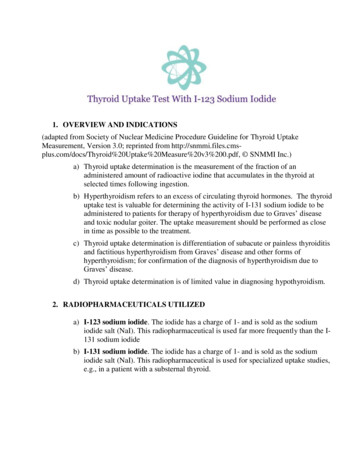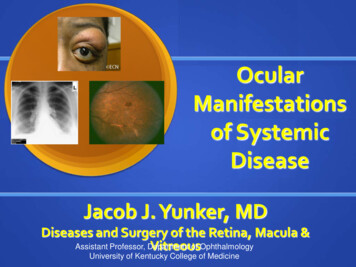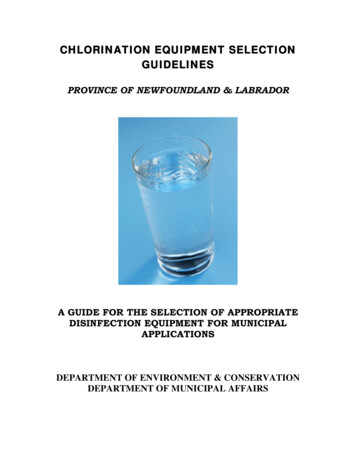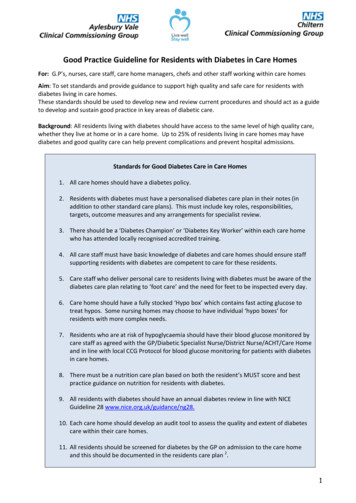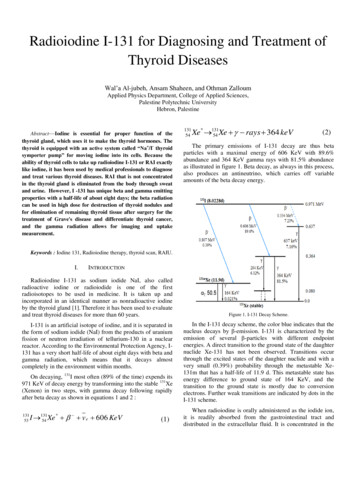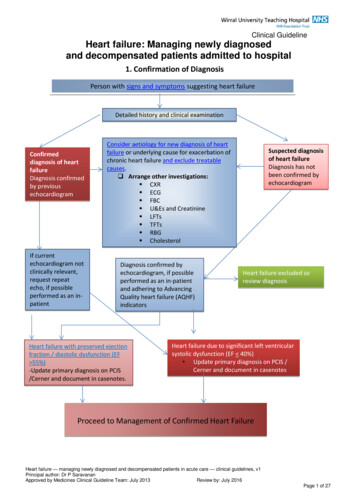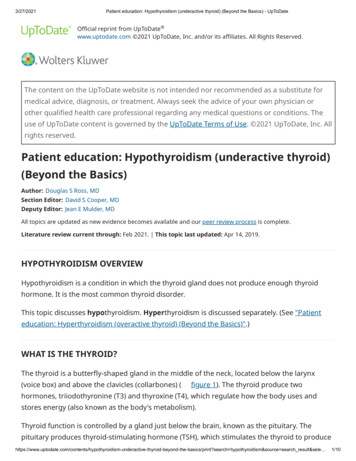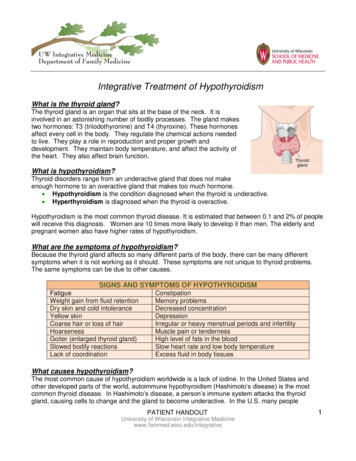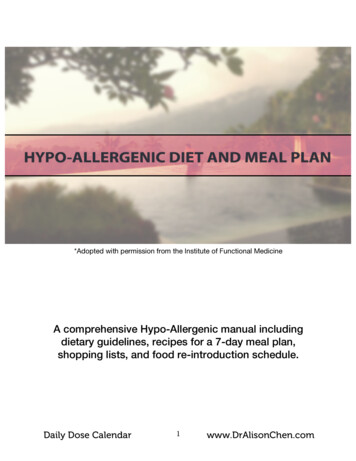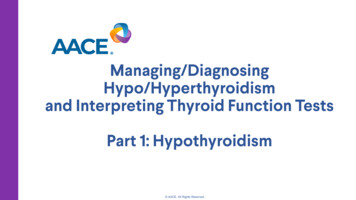
Transcription
Managing/DiagnosingHypo/Hyperthyroidismand Interpreting Thyroid Function TestsPart 1: Hypothyroidism AACE. All Rights Reserved.
FacultyDeepti Bahl, M.D.Assistant ProfessorDivision of Endocrinology, Diabetes and MetabolismUniversity of Alabama at Birmingham AACE. All Rights Reserved.
Definition and Epidemiology Hypothyroidism is traditionally defined asdeficient thyroidal production of thyroidhormone Prevalence of overt hypothyroidism variesfrom 0.1 to 2 percent. Hypothyroidism is five to eight times morecommon in women than men. AACE. All Rights Reserved.
PrimarySecondaryPeripheral Autoimmune disease(Hashimoto thyroiditis)–most common in US Iodine deficiency–mostcommon world wide Surgery/Radiation therapy Medications (eg, lithium,Tumors (pituitary adenoma,craniopharyngioma, meningioma)(massive infantileTrauma (surgery, irradiation, headhemangioma) injury) Mutations in genes encodingInfections (abcess, tuberculosis,for MCT8, SECISBP2, TRα orsyphilis, toxoplasmosis)TR β (thyroid hormoneInfiltrative (sarcoidosis,resistance)histiocytosis, hemochromatosis)tyrosine kinase inhibitors)Consumptive hypothyroidism Chronic lymphocytic hypophysitis Drugs (dopamine, glucocorticoids) AACE. All Rights Reserved.
Diagnosis of Primary Hypothyroidism Primary hypothyroidism indicates decreased thyroidal secretion of the thyroid hormoneby factors affecting thyroid gland itself. Fall in serum concentrations of thyroid hormone causes an increased secretion of TSHresulting in elevated serum TSH concentrations. Characterized by high TSH and low Free T4 Thyroid peroxidase (TPO) antibodies are elevated in majority of patients with chronicautoimmune thyroiditis. AACE. All Rights Reserved.
Manifestations of Hypothyroidism Common symptoms: fatigue, cold intolerance, weight gain,constipation, dry skin, myalgia, and menstrual irregularities Physical examination: goiter, bradycardia, diastolic hypertension,and a delayed relaxation phase of the deep tendon reflexes Metabolic abnormalities: hypercholesterolemia, macrocyticanemia, elevated creatine kinase, and hyponatremia AACE. All Rights Reserved.
Case Study Knowledge CheckA patient with hypothyroidism comes to you and requests a switch to Armour(combined T4/T3) thyroid because she was told it was more natural and betterthan levothyroxine.You tell her:A. Yes, it is has been proven to be betterB. There is clear proof that patients don’t like itC. Some patients prefer it but there is higher risk of TSH suppression andmonitoring is neededD. A combination of T3 and T4 separately is better AACE. All Rights Reserved.
Case Study Knowledge CheckA patient with hypothyroidism comes to you and requests a switch to Armour(combined T4/T3) thyroid because she was told it was more natural and betterthan levothyroxine.Answer is C:Some patients do prefer combination therapy. There is no clear proof ofsuperiority in blinded studies and there is a greater risk of TSH suppression.Triiodothyronine (T3) or desiccated thyroid should not be used in pregnancy. AACE. All Rights Reserved.
T3/T4 PharmacologyThyroxine (T4) Half life 7 days Stable/long acting Intestinal absorption of oral T4 is 80%Triiodothyronine (T3) Half life 0.75 daysT3/T4 ratio: 1:13 Onset of action: 2–4 hours Rapidly absorbed Marked blood level fluctuations May falsely suppress TSH if taken close to bloodwork AACE. All Rights Reserved.93%7%
Treatment of Primary Hypothyroidism Goal to normalize TSH T4 (levothyroxine, Synthroid) drug of choice Generic/brand-name bioequivalent but alteredbioavailability reported Full replacement dose usually about 1.6 mcg/kg Absorption more complete/ less erratic infasting state Patients advised to take L-T4 tablets in morningor late evening AACE. All Rights Reserved.
Treatment of Primary Hypothyroidism Some patients don’t need full replacement atfirst; never wrong to start low and titrate up Careful in CAD, elderly: start with lowerdose 25-50 mcg/day Avoid taking with iron/calcium - impairsabsorption Dose titrated up to normalize TSH Recheck 6-8 weeks after dose changes and 6-12months thereafter AACE. All Rights Reserved.
What About T3?Treatment of choice: levothyroxine (LT4)*Evidence does not support use of LT3/LT4 combinations†LT3 liothyronine*Strong recommendation. Moderate quality evidence (Jonklaas J et al. Thyroid. 2014;24(12):1670-1751).†Grade B recommendation because of unresolved issues raised by studies that report some patientsprefer, and some patient subgroups may benefit from, LT4 and LT3 combination (Garber J, et al. EndocrPract. 2012;18(6):988-1028). AACE. All Rights Reserved.
T3/T4 Combinations Armour thyroid / NP thyroid 1 grain 60 mg–contains T3 9 mcg, T4 38 mcg Nature-throid and Westhroid 1 grain 65 mg: contains T3 9 mcg, T4 38 mcg Pharmacologic equivalence: 74 mcg of T4 T3 is four times more potent than T4 (9 x 4 36 36 38 74) Clinically 90-100 mcg of Levothyroxine AACE. All Rights Reserved.
Conditions Requiring Dose AdjustmentIncreased dose requirement1. Decreased intestinal absorption of T4 Dietary fiber supplements Reduced gastric acid secretion: H.pylori infection, atrophic gastritis, proton-pumpinhibitors Malabsorption: coeliac disease, short bowel syndrome, lactose intolerance,bariatric surgery Bile-acid sequestrants Agents that bind L-T4: sucralfate, aluminum hydroxide, ferrous sulfate, calciumcarbonate, sevelamer AACE. All Rights Reserved.
Conditions Requiring Dose AdjustmentIncreased dose requirement2. Increased need for T43. Increased metabolic clearance of T4 Weight gain Antiepileptic drugs (phenobarbital, Estrogensphenytoin, carbamazepine) Pregnancy Tuberculostatic drugs (rifampicin) AACE. All Rights Reserved.
Conditions Requiring Dose AdjustmentDecreased dose requirement1. Decreased need for T4 Weight loss Androgens2. Decreased metabolic clearance of T4 Old age AACE. All Rights Reserved.
Central Hypothyroidism Decreased thyroidal secretion of hormone caused by insufficientstimulation of thyroid gland by TSH. Pituitary TSH release (secondary hypothyroidism) Hypothalamic TRH release (tertiary hypothyroidism) Characterized by Low T4 concentration/ TSH not appropriately elevated Central hypothyroidism less common than primary hypothyroidism AACE. All Rights Reserved.
Central Hypothyroidism Should be suspected in the following circumstances: There is known hypothalamic or pituitary disease A mass lesion is present in the pituitary When symptoms/signs of hypothyroidism associated with pituitaryhormonal deficiencies Goal of replacement therapy is to Titrate FT4/FT3 to mid-upper normal. TSH not monitored as it is unreliable. AACE. All Rights Reserved.
Case Study Knowledge Check50-year-old man had splenectomy after motor vehicle accident 10 years ago. He isadmitted with pneumococcal sepsis to the intensive care unit. During admission,thyroid function studies show decreased levels of total serum T3 and T4, low-normalTSH, and increased levels of reverse T3.Select the Next Step:A. Initiate thyroxineB. Radioactive iodine thyroid uptake testC. Thyroid ultrasoundD. Start DexamethasoneE. Continue to monitor patient and recheck thyroid function after illness resolve AACE. All Rights Reserved.
Case Study Knowledge Check50-year-old man had splenectomy after motor vehicle accident 10 years ago. He isadmitted with pneumococcal sepsis to the intensive care unit. During admission,thyroid function studies show decreased levels of total serum T3 and T4, low-normalTSH, and increased levels of reverse T3.Correct Answer is E:Continue to monitor patient and recheck thyroid function after illness resolves.This clinical and biochemical picture is suggestive of Euthyroid Sick Syndrome/Non- thyroidal illness syndrome. AACE. All Rights Reserved.
Thyroid Function in Nonthyroidal Illness Euthyroid Sick Syndrome/ Non-thyroidal illness syndrome/ Low T3 syndrome. Many hospitalized/ill patients have low/low-normal serum T4, low T3, andlow/low-normal/normal TSH. Similar to pattern in central hypothyroidism. Changes possibly protective in severe illness -prevent excessive tissuecatabolism. Patients receiving glucocorticoids, dopamine, dobutamine may have lowserum TSH. Unusual for TSH to be undetectable in the absence of thyrotoxicosis. AACE. All Rights Reserved.
Thyroid Function In Non-Thyroidal Illness Thyroid function should not be assessed in seriously ill patients unless a strongsuspicion of thyroid dysfunction. TSH, Free T4, and Free T3 needed to differentiate non-thyroidal illness from thyroiddisorder. Possibility of adrenal insufficiency must be considered and ruled out, since treatmentof hypothyroidism might accelerate cortisol metabolism. In critically ill patients with low free T4 and total T3 who do not appear to have anunderlying primary thyroid disorder. Do not treat with thyroid hormone Repeat thyroid tests (TSH, free T4), typically in one to two weeks AACE. All Rights Reserved.
Myxedema Coma Myxedema coma represents decompensated state of severe untreatedhypothyroidism. The prognosis is poor with a reported mortality between 20% and 50%. Triad of hypothermia, hyponatremia, and hypercapnia. Common precipitating factors include cold exposure, infection, trauma,or anesthesia. AACE. All Rights Reserved.
Myxedema Coma Physical manifestations include hypotension, bradycardia,macroglossia, delayed deep-tendon reflexes. cold, clammy, and dry skin,nonpitting edema, and periorbital edema. Laboratory examination may reveal anemia, hyponatremia,hypoglycemia, hypercholesterolemia, and high serum creatine kinaseconcentrations. Most patients have low serum FT4 and high serum TSH. AACE. All Rights Reserved.
Myxedema ComaHypothyroidismMANAGEMENT OF MYXEDEMA COMALarge initial iv dose of 300-500 μg T4, if no response add T3Alternative- initial IV dose of 200-300 μg T4 plus 10-25 μg T3HypocortisolemiaIV hydrocortisone 200-400 mg dailyHypoventilationDon’t delay intubation and mechanical ventilation too longHypothermiaBlankets, no active rewarmingHyponatremiaMild fluid restrictionHypotensionCautious volume expansion with crystalloid or whole bloodHypoglycemiaGlucose administrationPrecipitating eventIdentification and elimination by specific treatment, liberal use ofantibiotics AACE. All Rights Reserved.
Myxedema ComaTherapeutic endpoints in Myxedema coma should be: Improved mental status Improved cardiac function Improved pulmonary functionMeasurement of thyroid hormones every 1-2 days to ensure a favorabletrajectory in the biochemical parameters. AACE. All Rights Reserved.
Subclinical Hypothyroidism Defined as elevated serum thyrotropin (TSH) level with normal levelsof free thyroxine (FT4). Affects up to 10% of the adult population. Most often caused by autoimmune (Hashimoto) thyroiditis. Greater risk of progression from subclinical to overt hypothyroidismin patients with circulating thyroid peroxidase antibodies. AACE. All Rights Reserved.
Subclinical Hypothyroidism May be associated with an increased risk of heart failure, coronaryartery disease events, and mortality from coronary heart disease. Patients may have cognitive impairment, fatigue, and altered mood. No evidence it is beneficial to treat persons aged 65 years or older Treatment usually indicated for patients with subclinical hypothyroidism and serum thyrotropin levels of 10 mU/L or higher. AACE. All Rights Reserved.
Subclinical HypothyroidismTSH VALUEPatient age 65 yearsPatient age 65 years4.5-6.9Measure TPO antibodiesFollow TSH measurement inasymptomatic patientsConsider treatment: Plan for pregnancy Significant hypothyroid symptoms Positive TPO antibodies GoiterNo treatment7.0-9.9Treat with levothyroxineConsider treatment withlevothyroxine 10Treat with levothyroxineTreat with levothyroxineAdapted from Subclinical Hypothyroidism: A Review. JAMA. 2019;322(2):153-160. doi:10.1001/jama.2019.9052. AACE. All Rights Reserved.
ATA GuidelinesHypothyroidism in Pregnancy Maternal hypothyroidism defined as TSH concentration elevated beyondupper limit of pregnancy-specific reference range. Pregnancy-specific TSH reference range should be defined as follows: Population / trimester-specific reference ranges for serum TSH duringpregnancy should be defined by a provider’s institute / laboratory. If TSH reference ranges not available, upper reference limit of 4.0mU/lmay be used. Treatment of overt hypothyroidism recommended during pregnancy. AACE. All Rights Reserved.
ATA GuidelinesHypothyroidism in Pregnancy Oral levothyroxine recommended treatment. Triiodothyronine (T3) or desiccated thyroid should not be used. Patients should be monitored with a serum TSH measurement everyfour weeks until mid-gestation, and at least once near 30 weeksgestation. Target TSH in the lower half of the trimester specific reference rangeor below 2.5 mU/L. AACE. All Rights Reserved.
ATA GuidelinesSubclinical Hypothyroidism in Pregnancy Pregnant women with TSH concentrations 2.5 mU/L should beevaluated for TPO antibody status. Levothyroxine therapy recommended for: TPO antibody positive women with TSH greater than pregnancyspecific reference range TPO antibody negative women with TSH greater than 10.0 mU/L AACE. All Rights Reserved.
ATA GuidelinesSubclinical Hypothyroidism in Pregnancy Levothyroxine therapy may be considered for: TPO antibody positive women with TSH concentrations 2.5 mU/Land below upper limit of pregnancy specific reference range TPO antibody negative women with TSH concentrations greater thanthe pregnancy specific reference range and below 10.0 mU/L AACE. All Rights Reserved.
ATA GuidelinesSubclinical Hypothyroidism in Pregnancy Levothyroxine therapy not recommended for TPO antibody negativewomen with a normal TSH (TSH within the pregnancy specific referencerange, or 4.0 mU/L if unavailable). Isolated hypothyroxinemia (free thyroxine concentration in the lower2.5th -5th percentile of a given population, in conjunction with a normalmaternal TSH) should not be routinely treated in pregnancy. AACE. All Rights Reserved.
ATA GuidelinesPre-conception Counseling Hypothyroid women should contact caregiver immediately upon confirmed orsuspected pregnancy. Serum TSH should be evaluated preconception, levothyroxine dose adjusted toachieve TSH value between lower reference limit and 2.5 mU/L. Hypothyroid patients receiving LT4 treatment with suspected or confirmedpregnancy should increase their dose of LT4 by 20-30% (administer 2 additionaltablets weekly of the patient’s current daily levothyroxine dosage). AACE. All Rights Reserved.
ATA GuidelinesPre-conception CounselingPostpartum: LT4 should be reduced to patient’s preconception dose followingdelivery. Thyroid function testing should be performed at approximately sixweeks postpartum. AACE. All Rights Reserved.
References1.Gwiezdzinska J, Wartofsky L. Thyroid emergencies. Med Clin North Am 2012; 96: 385-403.2.Jonklaas J, Bianco AC, Bauer AJ, Burman KD, Cappola AR, Celi FS, Cooper DS, Kim BW, Peeters RP, Rosenthal MS, Sawka AM.Guidelines for the treatment of hypothyroidism. Prepared by the American Thyroid Association task force on thyroidhormone replacement. Thyroid 2014; 24: 1670-1751.3.Wiersinga WM. Myxedema and Coma (Severe Hypothyroidism) [Updated 2018 Apr 25]. In: Feingold KR, Anawalt B, Boyce A,et al., editors. Endotext [Internet]. South Dartmouth (MA): MDText.com, Inc.; 2000-. Available 4.Biondi B, Cappola AR, Cooper DS. Subclinical Hypothyroidism: A Review. JAMA. 2019;322(2):153–160.5.Kwaku MP, Burman KD. Myxedema coma. J Intensive Care Med. 2007 Jul-Aug;22(4):224-31. doi: 10.1177/0885066607301361.PMID: 17712058.6.Alexander EK, Pearce EN, Brent GA, Brown RS, Chen H, Dosiou C, Grobman WA, Laurberg P, Lazarus JH, Mandel SJ, PeetersRP, Sullivan S. 2017 Guidelines of the American Thyroid Association for the Diagnosis and Management of Thyroid DiseaseDuring Pregnancy and the Postpartum. Thyroid. 2017 Mar;27(3):315-389. doi: 10.1089/thy.2016.0457. Erratum in: Thyroid. 2017Sep;27(9):1212. PMID: 28056690. AACE. All Rights Reserved.
Maternal hypothyroidism defined as TSH concentration elevated beyond upper limit of pregnancy-specific reference range. Pregnancy-specific TSH reference range should be defined as follows: Population / trimester-specific reference ranges for serum TSH during pregnancy should be defined by a provider's institute / laboratory.
